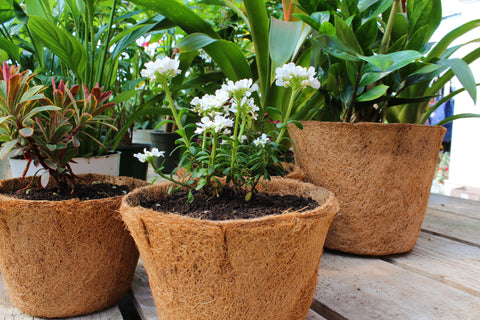Growing with Coconut Coir
What is Coconut Coir?

Coconut coir growing medium comes from the coconuts fibrous husk (known as coir) that is bound together by lignin (known as pith). After the husk is immersed in water for 6 weeks, the fiber is extracted mechanically, and the pith is left behind as a waste product and stored in heaps to age. Coir is the coarse fibers and sponge-like pith material that make up the thick husk of the coconut fruit.
Since the pith comes from the fruit, it is quite naturally rich in nutrients. Coconut coir growing mediums are dehydrated and compressed into a compact form for easy handling. With the addition of water, coir expands to an easy to work with growing medium. The addition of water increases the volume 3 to 9 times, depending on the packaging of products. This process results in an organic, biodegradable growing medium, making it a natural and safe choice for growers.
Why Use it?
It’s a spongy, soil-less growing medium that may be added to soil or potting media to increase moisture retention, drainage, and aeration, much like peat moss, perlite, or vermiculite. Coir has superior water holding capacity allowing for excellent air space and drainage. Coir can be used as a soil amendment for potted plants, containers, and gardens. Coir is easier to hydrate and lasts longer in soil than peat moss, all the while not destroying natural peat bogs. Coco coir also helps break up hard clay soils so that nutrients can be used more efficiently.
Kinds of Coco Products
Coconut coir is available in several formats:
- Compressed blocks of bulk coconut coir, such as the Plantonix 10 lb Coco Bliss Bricks which are rehydrated and broken apart before use.
- Shaped coconut coir products, like Plantonix Coco Coir Pots which help with transplant shock and are good for seedling starters
- Compressed Disks Such as Plantonix Coco Coir Disks which are easy to store and can be hydrated directly in a pot. These are best for small-scale potting.
Buffering Your Coco Coir
When using coco peat as a growing medium, we highly recommend buffering the coco peat products. The buffering process involves pre-soaking the coir for 12-24 hours with a buffering solution high in calcium; this displaces the sodium and balances the naturally occurring potassium. After the soaking period, the media is washed with water, this removes the displaced sodium, leaving the calcium in the coir. This buffering process prevents unwanted drawdown or 'lockout' of calcium and magnesium and avoids sodium toxicity issues.
Using Coconut Coir in Container Gardening and Hydroponics

Garden soil and container garden potting mixes benefit from the addition of coconut coir for moisture retention. It’s an excellent choice when you want to help fast-draining soils hold onto water a little bit longer.
Coconut coir can also be used as the growing medium for both seedlings and mature plants, as rooting mats and growing baskets, and for rooting plant cuttings. No matter what form of coco coir you’re using, always wet it thoroughly before you plant, and pay careful attention to the moisture level during the growing process. When starting seedlings or rooting plant cuttings, it’s a good idea to mix some coconut coir chips or perlite with the coconut coir to help increase air circulation in the root area.
Whether used in hydroponic systems or containers, by itself or mixed with other media, coconut coir can play a key role in providing an ideal growing environment for your plants. When using this growing medium in a hydroponics system, be sure to use buffered coco coir so it won’t tie up the calcium and magnesium in the nutrient solution. You can buffer your coco by following the steps provided below.









Leave a comment